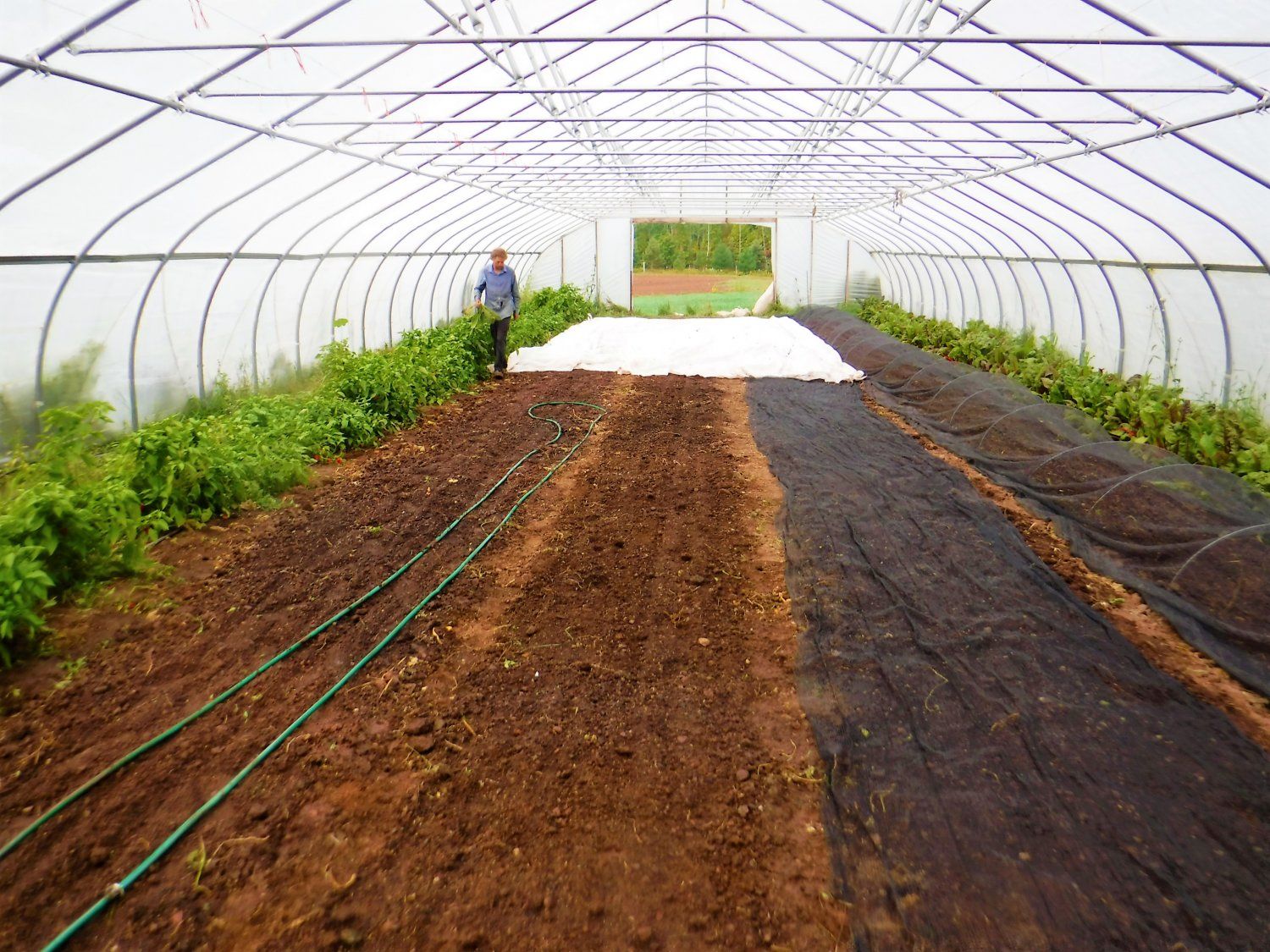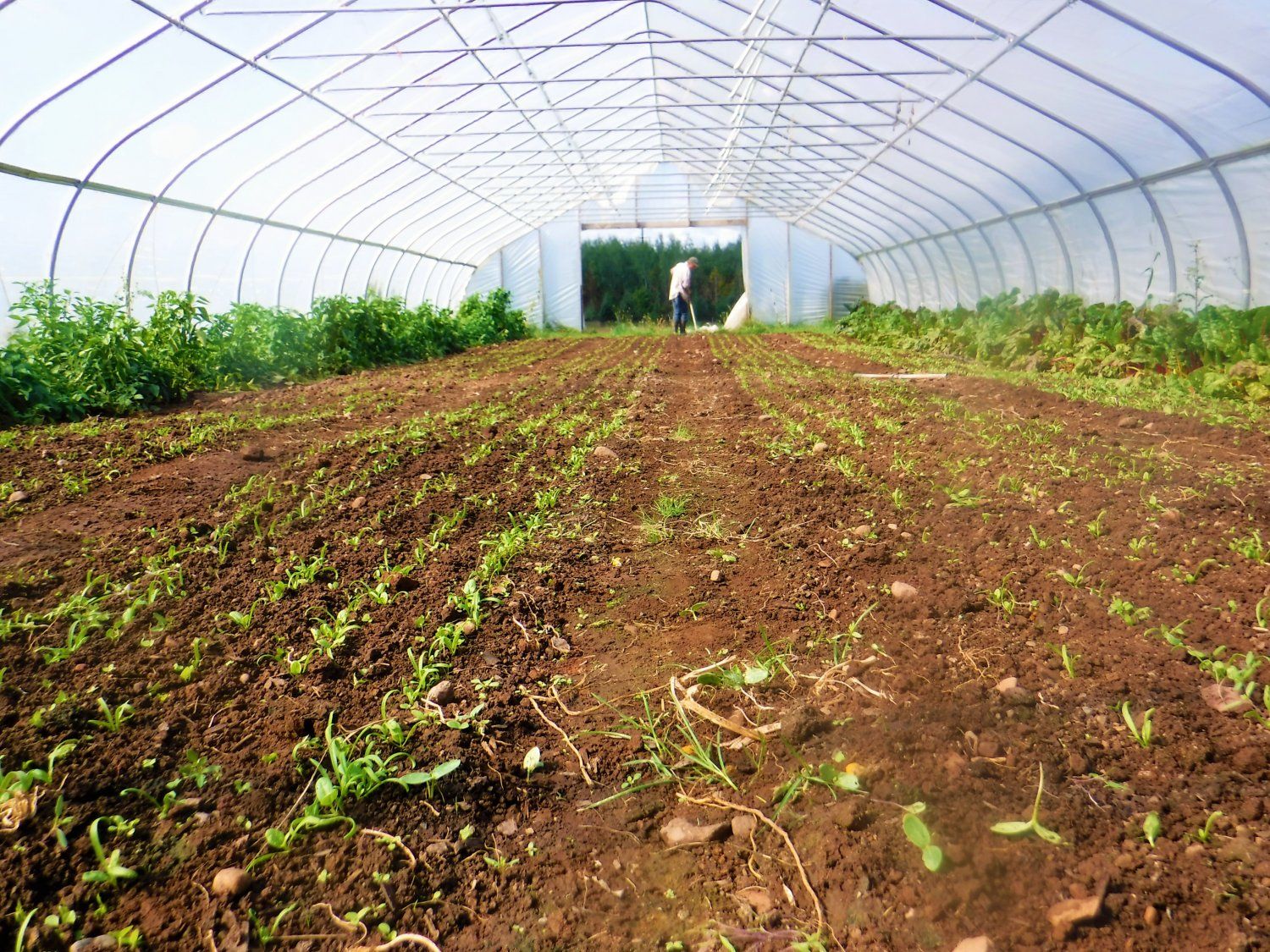September rains have finally arrived, and we're thankful. Last weekend we got 1.1 inches of rain overnight, our largest single precipitation event (other than the 2.5 inches in 20 minutes deluge we got in July) since mid May! The rain last night was also well received, adding another 1.1 inches to our September rainfall tally. The crops are thankful too, and the soil feels, looks, and smells alive again. Still many inches to go before we hit "average" precipitation, but we're making progress in the right direction.
This week, we started the big onion harvest, and sadly it was much more disappointing than we had expected. We've still got a few beds of onions left to harvest, but it looks like the crop this year was only about 1/3 of our crop last year - and we planted a little more this year. In order to stretch our supply, we will not be offering any more onions until Winter CSA Veggie Boxes begin in November, and even then we won't be offering them every week. On a normal onion harvest year, this wagon would be stacked full of bags.
While each of the farms in our cooperative have seen struggles this summer due to the drought, the onions are the first sizable casualty here at Great Oak Farm. Their short root systems just don't let them reach very far down for moisture, and despite our best efforts with limited irrigation, yields were down quite a bit. We're really looking forward to having a large irrigation system to pump out of our pond next season to see what kind of positive impact timely watering can have. Where there were low spots in the field, the onions did size up nicely, so it looks like water is our primary limiting factor. Check out these gorgeous red onions!
The warm weather in the forecast this coming week is also fine by us farmers. Tomatoes - both cherry and slicer tomatoes - are starting to slow down a bit, but continue to thrive. No frost in the forecast lets us focus on harvesting crops at a reasonable pace instead of cramming big harvests in and working late hours to finish the job before the weather turns bad. I know we'll get there at some point this fall, but we're thankful to have another week for tender crops to grow without worry of frost damage.
Speaking of tomatoes, I have 2 important words for you: BALSAMIC GLAZE. It's a balsamic reduction that is thick and syrupy, and adds incredible flavor to tomato salads when drizzled on top. Seriously, it's SO GOOD! Chop up whatever tomatoes you have on hand, along with finely chopped basil or basil microgreens, add salt and pepper, a little olive oil, fresh mozz or feta if you like, drizzle some balsamic glaze on top, and indulge. Balsamic glaze is going to be a regular staple in our fridge from here on out.
This week, the carrots in your CSA boxes are some new-to-us varieties that we are trialing. Next week, when we harvest, we'll bring out a large tape measurer and do some yield evaluations, but this week was all about general observations and taste testing. The varieties are (pictured below left to right) Newhall, Jerada, and Caravel.
The Newhall are stout, pointy bottomed, crisp, nice and sweet. Farmer Alex dubbed the Jerada carrots the "champagne of carrots" due to their snappy crunch, more delicate size (easy to eat without cutting/peeling), and refined carroty flavors. The Caravel carrots are medium sized with a more rounded bottom, taste very sweet, and have an almost creamy texture similar to a fresh salad turnip. It's neat to compare them side by side. When we wash and bag the carrots, they are all mixed together, but hopefully this picture can help you identify which ones you are eating. Let us know how YOU think they taste!
A note on the sweet corn this week - the moths beat us to the crop this week, and that rain last weekend seems to have washed away our protective bacteria. Scouting the field this week, it looks like most of the ears have a little caterpillar at the tip of the ear. Some ear tips have more caterpillar damage than others, and you may see debris from chewing the tip as well as "frass" aka caterpillar poo, but the rest of the ear of corn is still fine to eat. The damage is only cosmetic, and will only be at the tip of the ear. Trim off the tips of the ears when you shuck them, and 99% of the ear will be as good as ever - you won't even miss that tip! As an apology for the caterpillar damage, we'll be including one extra ear free (so 7 ears total instead of 6) with each order of sweet corn this week. Organic farming is always a dance of so many moving parts, and sometimes the pests get the upper hand. Thanks for your understanding.
Also on the corn front, a neighbor stopped by yesterday and picked up 100 ears of corn to process and freeze. He got some last year, and said it was the sweetest corn he'd ever eaten. We might be a little biased, but we agree! If you'd like to purchase some bulk organic sweet corn for freezing, we'll be offering 50 ear sacks of corn this week for $35. We try to get a few hundred ears worth of corn in our chest freezer for winter soups and sides, and in the middle of winter, that sweet corn tastes like candy. We trim off the corn from the ear and then blanch it for a few minutes in boiling water before cooling it in an ice water bath and sealing it up in zip lock freezer bags.
After we finish harvesting a bed of sweet corn, I always look forward to getting it all mowed down nice and tidy again. There's just something so satisfying about a nice orderly field after a season, taming of the chaos of summer, both in my mind and on the ground. Mowing it down is like checking something off the "to-do" list for the rest of the year. After a bed is mowed down, instead of having to constantly monitor the corn (and worry about the many factors that affect production), I can simply enjoy the understory crop of clover growing up through the mowed debris, knowing that the living soil is protected for the long winter ahead. That sure feels good.
One big project this week (in between all the harvesting, etc - sheeesh...) was fixing the hydraulics on our cultivating tractor, the little red Farmall Cub. Earlier this summer as you may recall, the hydraulics that raise and lower the cultivators quit working. Between waiting for parts and finding time to work on it, this week happened to be THE WEEK to get after it.
Diagnosing tractor problems and taking tractors apart is not my favorite task. Usually, it's never as easy as it seems - broken things do not disassemble and reassemble nearly as easily as working things. Something as simple as unscrewing a bolt - a 60 second project - can easily turn into a multiple day task if that bolt shears off. It took over 16 hours of work (working after work, in the evenings, and on the weekend) to take the tractor apart, pull the hydraulic system and pump, disassemble them, clean and replace all gaskets and O rings, and reassemble.
When I took it apart, I replaced some dust boots over 2 pistons that likely were the original late 1940's dust boots. The replacement boots (protective covers) were made of rubber, but the ones I replaced were made of white leather, painted red on the outside (though they were so dirty and torn that you could hardly see the red paint showing through any more), and held in place with thin wire on either end. It was pretty neat to find, and made me feel like I had stepped back in time a bit. Imagine if new tractors had protective parts made of painted leather.
Wednesday night at 8 pm, once the tractor was put back together, gas tank and fuel lines reinstalled (of course you have to remove them to access the hydraulics), I refilled the oil and turned the tractor on with fingers crossed.... And it still didn't work.
The feeling of defeat can be overwhelming at times like these. Taking the tractor to a mechanic to fix the system would likely cost half of the total value of the tractor, so as small farmers it's up to us to figure these systems out.
After eating some chocolate to boost morale, I put the question out to the Farmall Cub Facebook group, a bunch of Cub enthusiasts across the US and beyond. Mostly the group is old timers who can take a Cub apart and put it back together in their sleep. They can tell you what size wrench is needed for about any bolt on the entire tractor without looking, and lucky for me they enjoy helping other Cub owners with repairs and maintenance. By Thursday morning, they had given me some ideas on what to check next, and after spending another hour on it before work on Thursday morning, the hydraulics were finally beginning to move again, though not nearly well enough to adjust the cultivators that we attach underneath it to control weeds. Hopefully this weekend (and after some more chocolate!) I can dig deeper and get those hydraulics moving like they should again. Ah, farming.
That's it from the farm this week. I hope you enjoy taking a "peek under the hood" of one small farm in these Farm Happenings. Growing food is so much more than first meets the eye. Thanks so much for putting your faith in us farmers to get good food on your table. It's truly an honor to be your farmers!
In community,
Farmer Chris
Great Oak Farm

.JPG)
.JPG)
.JPG)
.JPG)
.JPG)
.JPG)
.JPG)
.JPG)



